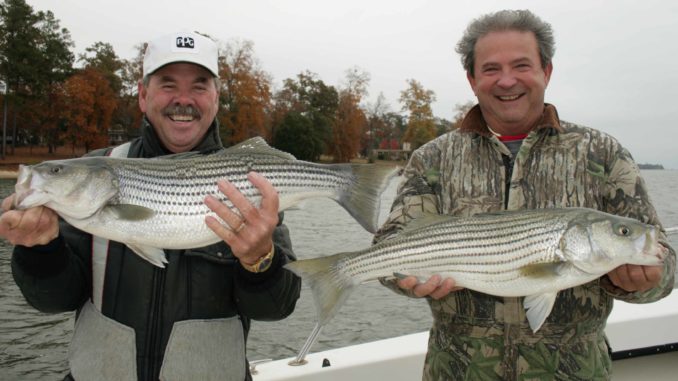
Stakeholders have helped striped bass recover
Striper fishing on Lake Marion or Lake Moultrie has been closed since June, and won’t open until October, but there has been much work behind the scenes this summer.
One of the biggest challenges facing the Santee Cooper lakes in recent years has been the effort to restore the striped bass fishery to a high level. At one time, Santee Cooper was THE freshwater striped bass fishery in the United States — in the world, for that matter. However, a series of events — too varied, controversial and numerous to outline here — caused the fishery to decline. What is important is not what caused the decline but what is being done to correct it and the efforts being made to bring the fishery back.
A request from the S.C. Department of Natural Resources to the South Carolina legislature was a key to this process. That request was to form a Striped Bass Stakeholders Committee Group that worked in conjunction with the SCDNR and the legislature to make regulatory and other changes in efforts to bring the population back and bring a once-great fishery back to a high level.
The legislature appointed stakeholders, those directly involved with the success of the lakes though vested interests to the economy and the fishery, to a committee to provide unique perspectives and valuable insights and make recommendations to the lawmakers to make the right decisions.
One stakeholder involved from the beginning is Allan Weiss, co-owner of Blacks Camp on Lake Moultrie. He said the committee, comprised of citizens from the headwaters of the Congaree and Wateree rivers to the ocean, includes all of the Santee Cooper lake system and the Cooper River, to ensure complete coverage.
“There were about 40 members, and all of us were directly involved and concerned about the striped bass fishery in Santee Cooper,” Weiss said. “During the process, the active numbers have dwindled, and some of the members have changed, but the goal remains the same: to do what’s best for the striped bass fishery in Santee Cooper.
“We set out on a seven-year plan that involved specific regulations that increased the size limit to 26 inches — which should be a sexually mature, spawning fish — a big increase from a size limit that at one time was only 18 inches. It also included a no-fishing season for stripers during four months of the summer when catch-and-release is much less effective. The goal was not to curtail fishing, but to bring back a population of sexually mature stripers, so in the years when conditions were conducive for natural spawning, the fishery would hit the jackpot, adding to the fingerlings SCDNR releases every year in conjunction with a big natural spawn that would dwarf any single stocking effort.”
Weiss said that the first part of the plan appears to be working.
“The striped bass population is back,” he said. “The numbers of fish that we’re seeing now compared to even just a few years ago is phenomenal. Some fishermen are still not seeing as many keeper-sized stripers as they’d like to see, but the study period of seven years is not complete yet. That’s why a provision was added to the legislative bill where after seven years, SCDNR is to make recommendations based on data from studies to see if it is working as planned or if it needs to be tweaked in some areas to make it the best-possible product to support the striped bass fishery on the lakes.
“The stakeholder committee has remained intact, and we still meet,” he said. “We met in June and will meet again in September with the leadership of the SCDNR to discuss possible recommendations for the striper fishery. SCDNR will make recommendations, and the legislature has the authority to pass legislation. But the stakeholder group, while we have no legislative authority, does have a voice in the process to ensure the decision makers know our views. Next year is the year when the law will be re-visited, and a lot of decisions must to be made. The stakeholders and legislature need to have all the data possible on the spawning, survival and growth rates of stripers, the sizes of fish caught, how the catch and release is working and the impacts of law enforcement on the striped bass fishery. The SCDNR is preparing that information now.”
Weiss said much information has been gathered, but much more still needs to be done before final decisions are made.
“The time is drawing near where final conclusions about the existing regulations and laws must be made to determine if they are working or are they too strict or not strict enough,” he said. “The bottom line is, we want the striped bass fishery to become stable at a very high level again. It is great that we’ve got the number of fish back up, but the job is not yet finished and there’s still work to be done. The stakeholder committee does not want to see all the hard work put into the last several years to be lost. It is an important time for the striped bass fishery. We have made great strides to get to where we are.
“But where we go from here is crucial,” Weiss said. “We certainly want to move forward, not backwards. It’s in the interest of everyone that is concerned with the fishery to voice concerns ideas and suggestions for the program as it moves forward into the future. With enough biological data and facts on the table and inputs from stakeholders, SCDNR, fishermen, citizens and then the legislature, we can not only keep the improvements we’ve made, but build on them to improve the fishery even more.”





Be the first to comment